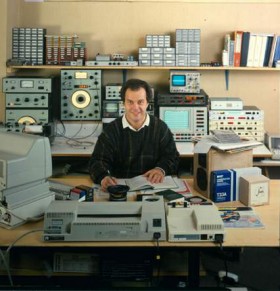Abstract
Leo Beranek was born in 1914 and spent his childhood in Mt. Vernon, Iowa. He attended Cornell College in Iowa and worked while studying as a radio and small appliance repairman. He received his Bachelor’s at Cornell College in 1936 and worked for Collins-Rockwell radio company in Cedar Rapids, Iowa. A chance encounter with Glenn Browning lead Beranek to apply to Harvard University for graduate study, where he was awarded a full scholarship. While at Harvard, Beranek begins working with Professor Hunt as his assistant at the university’s Cruft Laboratory. Beranek began work on a sound control project for the U.S. National Defense Research Committee in 1940, attempting to control vibration and sound in aircraft used in the war effort. The Kamikaze pilot dilemma of W.W.II initiated Beranek’s second defense project, the effort to speed up marine on-board communications. Beranek, with co-founders Bolt and Newman, starts Bolt, Beranek, and Newman in 1948. BBN starts as an acoustical consulting firm, but later entered the budding industry of computing and did contract work with NIH and ARPA.
Beranek discusses his childhood fascination with radio and his education at Cornell College (Iowa) and Harvard. He details some of the work he did in acoustics during World War II, and the formation of a consulting form BBN, after the war. Beranek also discusses some of the events surrounding the formation of the IRE Professional Group on Audio and its relationship with the Audio Engineering Society.
Table of Contents
(Page numbers refer to pages in the printed transcript held at the IEEE History Center. On-line, they should be used as relative measures)
1. Early childhood
Interest in radios/electrical engineering
2. Attended Cornell College in Iowa
Apprenticed to radio serviceman
3. Worked as radio repairman
4. Leaves Cornell College to work as a repairman
Worked for Collins-Rockwell radio company in Cedar Rapids
5. Returns to Cornell College, graduates in 1936
6. Decides to apply to apply to graduate school
Meets Glenn Browning of the Browning Company
7. Browning assists him in applying for scholarships
Accepted at Harvard University on full scholarship
8. Begins schooling at Harvard
Works at Harvard’s Cruft Laboratory
9. Works as Professor Hunt’s assistant in acoustics
10. Worked as Hunt’s assistant for two years
Hunt develops the lightweight pickup
11. Develops the folding horn
Begins acoustic experiments
12. Co-authors first publication on Morris’s acoustics theory,
published in Acoustical Society and Electronics
13. Awarded Harvard’s Parker Fellowship
Receives Ph.D. in 1940
14. Does acoustical work/creating sound field
15. Joins IRE in 1933
16. Designs studio, works as recorder operator
Acoustical Journal publishes paper
17. Begins teaching at Harvard as Faculty Instructor
National Defense Research Committee begins work on sound control project in 1940
18. Offered work at MIT as Compton’s assistant in NDRC project
19. Decision made to make Beranek supervise project at Harvard
20. Beranek made head of Harvard’s first government war project
21. Awarded huge budget by U.S. government, begins hiring assistants
22. Begins creating large laboratory with budget allotment
23. Begins research quieting airplanes
24. Begins research on high-altitude communications
Creates only existing airborne acoustics laboratory in U.S.
25. Begins work in psycho-acoustics
26. Work in psycho-acoustics
27. Researches the effect of altitude on voice, equipment
28. Finds need for high-altitude microphones, earphones
29. Presents need for equipment to army, navy and British Joint communications board
30. Finds needed equipment at Western Electric company
31. Develops new methods of calibrating microphones, equipment
32. Publishes findings as book, Acoustical Measurements
Publishes “Design of Speech Communications Systems” in Proceedings of the IRE, 1946
33. Kamikaze pilot dilemma initiates second project in 1943
34. Begins research to speed-up marine on-board communications
35. Begins on-board research
36. Urges Navy to replace old equipment with more modern equipment
37. War ends, laboratory is shut down
38. Early member of the Audio Group, 1947-48
Joins MIT as tenured professor in 1947
Founds Section of the Institute of Radio Engineers
39. IRE formally establishes Audio Group, 1948
40. Industry moves away from audio to signal processing
41. Audio group becomes audio and electroacoustics in 1965and acoustic speech and signal processing in 1974
42. Discussion of signal processing field
43. Assessment of artificial speech field
Telephony and military applications of artificial speech
44. Apparent by 1960s that audio technology would go to digital
45. Discussion of changes in Audio Group
46. Changes in Audio Group
47. Started BBN Bolt Beranek and Newman in 1948
Begins acoustical advising for construction of UN in New York
48. Beginnings of BBN Acoustical Firm
49. Leaves MIT to become president of BBN
BBN incorporated in 1953
50. Consulting firm works on quieting airliners, cars and building acoustics
51. Licklider joins BBN
52. Works with Minsky and McCarthy on time-sharing in computing
53. BBN buys its first computer
54. BBN does contract work with NIH and ARPA
55. BBN moves into computing
56. BBN works with space and underwater acoustics
Computing is not acoustic-related
57. BBN branches into computing via ARPA net
58. BBN’s success in business, computing
59. BBN works on packet switching, ARPA net contract, 1968
60. Develops high-speed network system for FAA
61. Begins heading Channel 5 in Boston
62. FCC awards Channel 5 license to Boston Broadcasters, Inc., Beranek’s company
63. Leaves presidency at BBN in 1971 to run Channel 5
Channel 5 goes on the air in 1972
64. Channel 5 is WCBB-TV
Beranek is president until 1982, when station is sold
Begins work for Wang, setting up networks
65. Chairman of the Boston Symphony
President of the Academy of Arts and Sciences
Served on the Board of Overseers at Harvard University
66. Currently working as Acoustics Consultant
67. Reflections of career
Discussion of BBN’s philosophy/strategy
68. Reflections of years with BBN
69. BBN development of fuel cell project
70. Discussion of BBN consultants, employees
71. BBN develops Telcomp programming language
72. Foresaw importance of PC computing
73. Advice for young engineers
74. Advice for young engineers
Final thoughts




